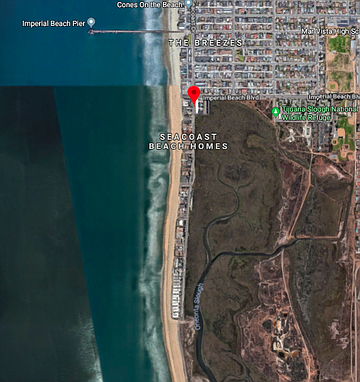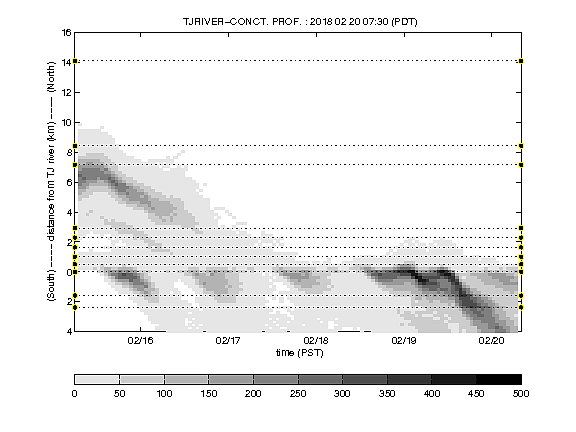 Facebook
Facebook
 X
X
 Instagram
Instagram
 TikTok
TikTok
 Youtube
Youtube

The sewage stink from the beach south of Seacoast Drive in Imperial Beach started about a quarter-mile north of the Tijuana River mouth on February 17th, with the first hints marked by that pungent, green, overripe smell that can be the smell of new growth. But a few more southbound steps and it was clear that it was sewage.

The spill started flowing our way three days earlier, on February 14th, when pump station Cila shut down, temporarily stopping its mission of diverting river flow to treatment plants. From 9 p.m. February 14th to 3 p.m. the 15th, sewage, storm runoff, and whatever trash had accumulated in the channel flowed into the U.S. unchecked.
The river flow began with a dribble at 8 p.m. but two hours later it was rushing through at 1 cubic meter per second (cms). For an hour and a half, it pushed through at 1.5 cms, then slowed to 1 cms around 1:30 a.m. February 15th. It eventually fell to around .9 cms around 5 a.m. and continued to ease until the pump station came back on at 3 p.m., according to the gauge that measures the river flow, operated by the International Boundary and Water Commission.
Consider that one cubic meter per second equals 264 gallons per second, or 950,400 gallons per hour: for 17 hours, the nasty mix blasted across the flatlands at the end of the river’s concrete channel.

It takes a serious amount of spill — in the hundreds of thousands of gallons or more — before the stench is smelled at the ocean. It first floods the lowlands just west and then north of the end of the concrete river channel’s painted yellow line. At the end of the concrete are acres of land that meander north to the Dairy Mart Road bridge.
Once it feeds under the bridge, the water courses through just less than six miles of river, parts of which are intermittently blocked by sediment and trash from previous flows.
Much of the time, sewage spills don’t make it past the bridge — or they become trapped a mile or two down the channel that is the river. Then, it’s only the residents, Border Patrol agents, hikers, and equestrians who know about the sewage. The county park staff can smell it, particularly east of Hollister, but the state park staff can’t.
But on the 17th, the smell told the story: 15 million gallons over 17 hours was enough to make the beach stink two days after the spill ended.
It's not as much as the roughly estimated 140-million-gallon spill last year around this time when Tijuana city workers routed sewage into the river channel so they could repair a broken main, but still... That number came from calculations off the same gauge. The International Boundary and Water Commission later said it was 28 million gallons.
One of the problems of reporting on such spills is that the definition of news is a new or unusual event. This isn’t that.


The sewage stink from the beach south of Seacoast Drive in Imperial Beach started about a quarter-mile north of the Tijuana River mouth on February 17th, with the first hints marked by that pungent, green, overripe smell that can be the smell of new growth. But a few more southbound steps and it was clear that it was sewage.

The spill started flowing our way three days earlier, on February 14th, when pump station Cila shut down, temporarily stopping its mission of diverting river flow to treatment plants. From 9 p.m. February 14th to 3 p.m. the 15th, sewage, storm runoff, and whatever trash had accumulated in the channel flowed into the U.S. unchecked.
The river flow began with a dribble at 8 p.m. but two hours later it was rushing through at 1 cubic meter per second (cms). For an hour and a half, it pushed through at 1.5 cms, then slowed to 1 cms around 1:30 a.m. February 15th. It eventually fell to around .9 cms around 5 a.m. and continued to ease until the pump station came back on at 3 p.m., according to the gauge that measures the river flow, operated by the International Boundary and Water Commission.
Consider that one cubic meter per second equals 264 gallons per second, or 950,400 gallons per hour: for 17 hours, the nasty mix blasted across the flatlands at the end of the river’s concrete channel.

It takes a serious amount of spill — in the hundreds of thousands of gallons or more — before the stench is smelled at the ocean. It first floods the lowlands just west and then north of the end of the concrete river channel’s painted yellow line. At the end of the concrete are acres of land that meander north to the Dairy Mart Road bridge.
Once it feeds under the bridge, the water courses through just less than six miles of river, parts of which are intermittently blocked by sediment and trash from previous flows.
Much of the time, sewage spills don’t make it past the bridge — or they become trapped a mile or two down the channel that is the river. Then, it’s only the residents, Border Patrol agents, hikers, and equestrians who know about the sewage. The county park staff can smell it, particularly east of Hollister, but the state park staff can’t.
But on the 17th, the smell told the story: 15 million gallons over 17 hours was enough to make the beach stink two days after the spill ended.
It's not as much as the roughly estimated 140-million-gallon spill last year around this time when Tijuana city workers routed sewage into the river channel so they could repair a broken main, but still... That number came from calculations off the same gauge. The International Boundary and Water Commission later said it was 28 million gallons.
One of the problems of reporting on such spills is that the definition of news is a new or unusual event. This isn’t that.
Comments